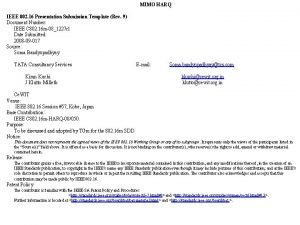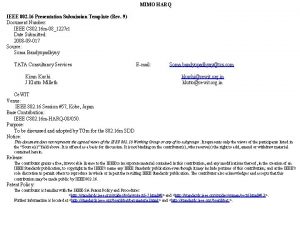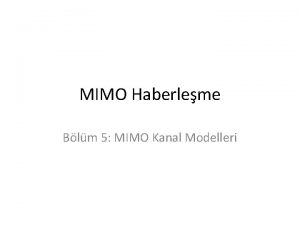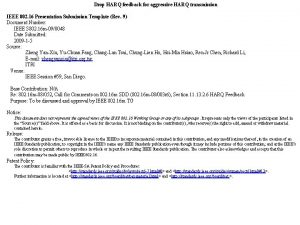HARQ with MIMO addition IEEE 802 16 Presentation




![Proposed text [Insert the following section in 16 m SDD] 11. x. 1. 1. Proposed text [Insert the following section in 16 m SDD] 11. x. 1. 1.](https://slidetodoc.com/presentation_image_h2/821af91f5a7ae38a4972c55bcab56ad2/image-5.jpg)
- Slides: 5

HARQ with MIMO addition IEEE 802. 16 Presentation Submission Template (Rev. 9) Document Number: IEEE C 802. 16 m-08_1227 r 1 Date Submitted: 2008 -09 -017 Source: Soma Bandyopadhyay TATA Consultancy Services Kiran Kuchi J Klutto Milleth E-mail: Soma. bandyopadhyay@tcs. com kkuchi@cewit. org. in klutto@cewit. org. in Ce. WIT Venue: IEEE 802. 16 Session #57, Kobe, Japan Base Contribution: IEEE C 802. 16 m-HARQ-08/050. Purpose: To be discussed and adopted by TGm for the 802. 16 m SDD Notice: This document does not represent the agreed views of the IEEE 802. 16 Working Group or any of its subgroups. It represents only the views of the participants listed in the “Source(s)” field above. It is offered as a basis for discussion. It is not binding on the contributor(s), who reserve(s) the right to add, amend or withdraw material contained herein. Release: The contributor grants a free, irrevocable license to the IEEE to incorporate material contained in this contribution, and any modifications thereof, in the creation of an IEEE Standards publication; to copyright in the IEEE’s name any IEEE Standards publication even though it may include portions of this contribution; and at the IEEE’s sole discretion to permit others to reproduce in whole or in part the resulting IEEE Standards publication. The contributor also acknowledges and accepts that this contribution may be made public by IEEE 802. 16. Patent Policy: The contributor is familiar with the IEEE-SA Patent Policy and Procedures: <http: //standards. ieee. org/guides/bylaws/sect 6 -7. html#6> and <http: //standards. ieee. org/guides/opman/sect 6. html#6. 3>. Further information is located at <http: //standards. ieee. org/board/pat-material. html> and <http: //standards. ieee. org/board/pat >.

Background • In 802. 16, both synchronous and asynchronous mode of HARQ are supported. It also uses HARQ with soft combining (erroneously received packets are stored in buffer memory and later combined with the retransmitted packets). • Set of coded bits transmitted in each retransmission can be varied provided they represent the same information bits, also the modulation scheme can be varied. Modes of are HARQ- IR and chase combining, where chase combining can be considered as a subset of the IR mode of HARQ. • In 802. 16 multiple antenna systems are supported.

Motivation • Who guides the resource-allocator to take the decision of synchronous and asynchronous HARQ Ø Drivers of synchronous and asynchronous HARQ • Combining synchronous and asynchronous mode of HARQ with adaptive and non-adaptive mode. Variation of MCS Rate matching block works according. • How spatial multiplexing, Transmit diversity affects HARQ-IR. • MIMO-HARQ. The intention of this proposal is to show the additional factors affecting the bit selection and repetition block incase of MIMO mode • Notation:

Proposal • Rate matching block – the core block of HARQ performs following • Follows MCS requirement as given by resource allocator • Varies combination of redundancy bits - thus code rate – IR (CC) comes as a subset for constant code rates. • Adds repetition to additional bits to meet the resource requirement. • Performs puncturing to reduce no. of bits to meet the resource requirement • The collected bits can be buffered and divided further into code blocks with different combination of systematic as well as redundancy bits • The output size of the rate-matched bits depends on the number of antenna port( no. of layers). • Methods and result – next contribution
![Proposed text Insert the following section in 16 m SDD 11 x 1 1 Proposed text [Insert the following section in 16 m SDD] 11. x. 1. 1.](https://slidetodoc.com/presentation_image_h2/821af91f5a7ae38a4972c55bcab56ad2/image-5.jpg)
Proposed text [Insert the following section in 16 m SDD] 11. x. 1. 1. 4 Bit selection and repetition 11. x. 1. 1. 4. 1 Additional factor/parameter of bit-collection block in case of MIMO mode • • Bit collection block - The main purpose of this block is to perform the rate matching as per the modulation and code rates indicated by the scheduler. This block can be further extended to control incremental code block rate for IR HARQ. Code block size which comes as an output of the rate matching block varies on the number of antenna ports / no. of layer to be supported. • Exact Mathematical relation coded bits with number of layers– next contribution N. B : This can also be considered as part of MIMO-HARQ section









